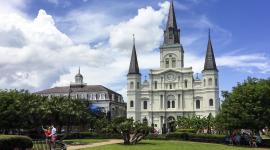Located in the city’s Navarre neighborhood, this seven-acre cemetery stands in contrast with many other New Orleans cemeteries as all of its graves are below ground. Aboveground burials are characteristic of the area because of the city’s high water table. However, Holt Cemetery serves as a potter’s field, a burial ground for those who cannot afford more costly aboveground graves. While it had previously been used as a burial ground for many years, it was officially designated as a cemetery in 1879 by Board of Health official Dr. Joseph Holt. In 1909 the size of the original 400-by-600-foot cemetery was increased with the addition of a plot on St. Louis Street. While it is the responsibility of the plot owners to maintain their respective plots, the cemetery grounds are owned and operated by the City of New Orleans.
This rectangular cemetery is enclosed by an iron rail fence with a concrete base and posts on its western edge, and opaque fencing on the remaining three sides. It features clusters of oak trees as well as a paved circular drive, and an oak tree is situated at each of the four corners of the site. The burials are grouped closely together in rows. Significant members of the jazz movement, such as Charles Joseph “Buddy” Bolden, reside here in unmarked graves. The funerary school of the adjacent Delgado Community College was once involved as stewards of the cemetery but no longer maintain it. Following Hurricane Katrina, burial, visitation, and maintenance activity slowed due to the displacement of many residents of the surrounding community. From 2013 to 2014 the cemetery underwent a renovation, which included the repair of its cottage, driveway, fencing, lighting, and signage.













